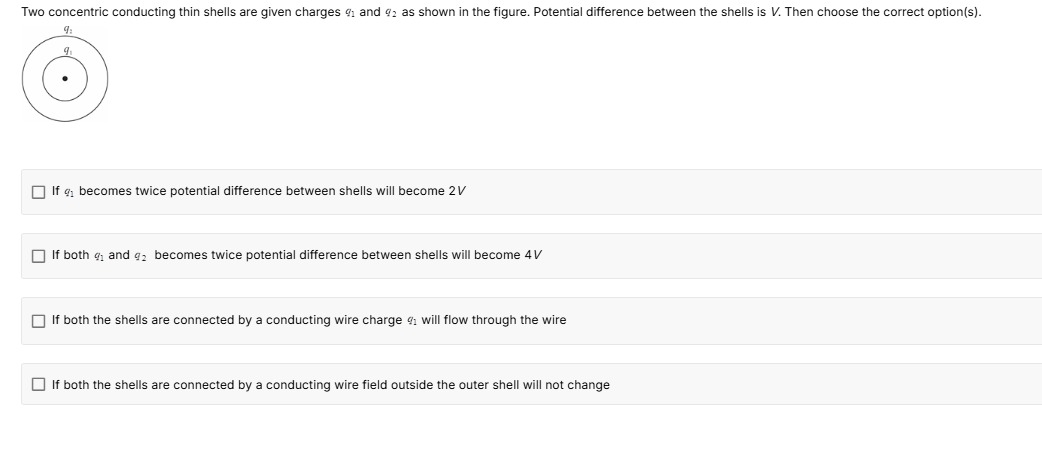Question
Question: Two concentric conducting thin shells are given charges $q_1$ and $q_2$ as shown in the figure. Pote...
Two concentric conducting thin shells are given charges q1 and q2 as shown in the figure. Potential difference between the shells is V. Then choose the correct option(s).

If q1 becomes twice potential difference between shells will become 2V
If both q1 and q2 becomes twice potential difference between shells will become 4V
If both the shells are connected by a conducting wire charge q1 will flow through the wire
If both the shells are connected by a conducting wire field outside the outer shell will not change
If q1 becomes twice potential difference between shells will become 2V, If both the shells are connected by a conducting wire charge q1 will flow through the wire, If both the shells are connected by a conducting wire field outside the outer shell will not change
Solution
Let the radius of the inner shell be r1 and the radius of the outer shell be r2. The charge on the inner shell is q1 and the charge on the outer shell is q2.
The potential at the surface of the inner shell (r=r1) is given by the sum of the potential due to the charge on the inner shell and the potential due to the charge on the outer shell.
Potential at r=r1 due to q1 is V11=4πϵ01r1q1.
Potential at r=r1 due to q2 is V21=4πϵ01r2q2 (since r1<r2, the potential inside the outer shell due to q2 is constant and equal to the potential on the surface of the outer shell).
So, the potential of the inner shell is V1=V11+V21=4πϵ01(r1q1+r2q2).
The potential at the surface of the outer shell (r=r2) is given by the sum of the potential due to the charge on the inner shell and the potential due to the charge on the outer shell.
Potential at r=r2 due to q1 is V12=4πϵ01r2q1 (since r2>r1, the potential outside the inner shell due to q1 is the same as a point charge at the center).
Potential at r=r2 due to q2 is V22=4πϵ01r2q2.
So, the potential of the outer shell is V2=V12+V22=4πϵ01(r2q1+r2q2).
The potential difference between the shells is V=V1−V2=4πϵ01(r1q1+r2q2)−4πϵ01(r2q1+r2q2)=4πϵ01(r1q1−r2q1)=4πϵ0q1(r11−r21).
Option 1: If q1 becomes twice, q1′=2q1, and q2 remains unchanged. The new potential difference is V′=4πϵ0q1′(r11−r21)=4πϵ02q1(r11−r21)=2V. This option is correct.
Option 2: If both q1 and q2 become twice, q1′=2q1 and q2′=2q2. The new potential difference is V′=4πϵ0q1′(r11−r21)=4πϵ02q1(r11−r21)=2V. This option states that the potential difference becomes 4V, which is incorrect.
Option 3: If both the shells are connected by a conducting wire. When connected by a conducting wire, the shells form a single conductor, and charge will redistribute such that the potential on both shells is equal. Since they are connected, they are at the same potential. In a conductor, charge resides on the outer surface. Thus, the charge from the inner shell will flow to the outer shell. The total charge on the system is q1+q2. After connecting, the charge on the inner shell becomes 0, and the charge on the outer shell becomes q1+q2. The charge that flowed through the wire from the inner shell to the outer shell is q1−0=q1. This option is correct.
Option 4: If both the shells are connected by a conducting wire, field outside the outer shell will not change. Before connecting, the electric field at a distance r>r2 from the center is due to the total charge q1+q2 enclosed within a spherical surface of radius r. By Gauss's law, E⋅4πr2=ϵ0q1+q2, so E=4πϵ01r2q1+q2. After connecting, the total charge remains q1+q2, and this charge resides on the outer shell. The electric field at a distance r>r2 from the center is still due to the total charge q1+q2 enclosed within a spherical surface of radius r. By Gauss's law, E′⋅4πr2=ϵ0q1+q2, so E′=4πϵ01r2q1+q2. Thus, the electric field outside the outer shell does not change. This option is correct.
